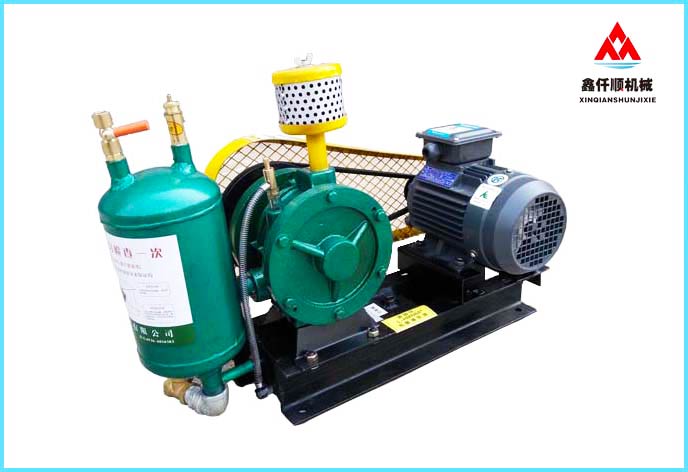1、 Source of fan noise
Fans are widely used in metallurgy, chemical industry, petroleum, machinery, cement, construction and other important departments, playing a very smelly and positive role in promoting industrial production and accelerating the pace of design. However, the strong noise generated by the fan during operation seriously affects the quietness of the environment. It will not only damage people's hearing, endanger health, hinder normal communication and language conversation in the workshop, and bring certain impact on safety production; Moreover, it seriously interferes with the rest of surrounding residents, office work and school classes. The following is a brief introduction to fan noise:
The fan is actually a positive displacement compressor, which is composed of a pair of waist shaped blades that are vertically meshed with each other to rotate at relatively high speed to transport gas. When the fan unit is running, the noise generated mainly includes air dynamic noise (i.e. air flow noise), transmission gear noise, motor noise and pressure regulating valve noise, among which the noise with the highest intensity and the greatest impact is considered as aerodynamic noise. It includes the periodic exhaust noise caused by the pressure pulsation caused by periodic exhaust when the fan impeller rotates, and the vortex noise caused by the gas vortex on the fan impeller interface. The intensity of exhaust is mainly related to the rotating speed of the impeller, the flow and static pressure of the fan exhaust, and its noise spectrum is often low and medium frequency, accompanied by a certain noise peak. Whirlpool noise depends on the shape of the fan impeller. The flow velocity and flow pattern of the air flow relative to the body generally produce high-frequency noise with continuous frequency spectrum.

When operating under certain working conditions, high intensity noise is radiated from the air inlet, air outlet, casing, pipes and other parts of the fan. Under the actual use conditions, the exhaust port of the fan is often connected with the gas transmission pipeline and closed. Therefore, the noise radiated from the air inlet is the strongest, and the interference to the environment is also the most serious. According to the actual measurement, the noise level from the fan air port can reach about 105~135 dB at "A" level, and about 110~140 dB at "C" level. The fan not only has high noise intensity, but also has complex and continuous frequency components. In order to quantitatively describe the distribution of its noise energy in the entire audio frequency range, octave filters are often used in noise measurement to conduct spectrum analysis and test on the noise at eight octave frequency bands from 63 Hz to 800 Hz, so as to obtain the noise spectrum characteristic curve of the sound source, that is, the relationship curve between octave sound pressure level and frequency. The noise spectrum curve features:
First of all, its noise spectrum is wide, that is, there is high noise in a wide frequency range, and low intermediate frequency noise is the main component. When the static pressure is low, that is, the load is small, the peak frequency is usually about 125 Hz at the low frequency; When the pressure rises to the rated static pressure, a new noise peak will appear at the intermediate frequency of about 500 Hz. This shows that the medium and high frequency noise will increase significantly with the increase of fan working pressure.
The noise intensity and frequency spectrum characteristics of the fan are not only related to the working static pressure of the fan, but also related to the flow and speed of the fan. For example, with the increase of flow, the noise will also increase accordingly. When the speed is doubled, the fan noise will increase by about 5~10 dB, especially the increase of medium and high frequency noise.
2、 Fan control measures
In addition to the noise at the tuyere, the solid sound transmission of fan body noise and vibration should also be paid attention to according to the site conditions. Rotary blower
The axial flow fan makes a lot of noise when working, and the fan noise also increases with the increase of air volume and air pressure. The following methods are usually used to solve the fan noise problem:
1. The noise of the enclosure and motor can be solved by installing a sound insulation cover. The fan is placed in an independent sound insulation room for sound absorption and insulation.
2. Install a muffler outside the fan exhaust port, with built-in muffler inserts to reduce the noise when passing through the muffler with special structure. Muffler is an effective measure to reduce the radiation from the air inlet and outlet of aerodynamic equipment or the noise transmitted along the pipe.
3. Louvers outside the ground floor shall be silencing louvers as far as possible. Rotary blower
4. Damper spring hanger shock absorber is used for fan suspension.
Targeted design shall be carried out according to the sound source object, noise characteristics, noise reduction requirements, process conditions, installation location and other factors to ensure good noise elimination and reduction effect.
Shandong Xinqianshun Machinery Co., Ltd. is a professional Roots blower supplier integrating design, development and sales. The company's products include Roots blower, Roots vacuum pump, centrifugal fan, rotary blower, single-stage high-speed centrifugal blower and countercurrent cooling vacuum pump. Main production Roots blower This product absorbs advanced technology and relies on a new generation of efficient and energy-saving products developed by scientific research institutes. It has reasonable structure, small size, high efficiency, low noise, stable operation, long service life, convenient maintenance and other characteristics, and is widely used in sewage treatment, mining, metallurgy, chemicals, building materials, electricity, light industry, flour, aquaculture and other fields. Over the years, it has been well received by users.








